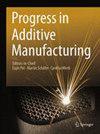Preliminary colour characterisation of a Stratasys J750 digital anatomy printer with different fillings and face orientations
IF 5.4
Q2 ENGINEERING, MANUFACTURING
引用次数: 0
Abstract
Abstract Multicolour capability in additive manufacturing could play a key role in certain applications such as surgical training and consumer products. However, the ability to accurately 3D print colours is not well documented and could affect the realism of models produced through these technologies. As a recent system, the Stratasys J750 Digital Anatomy Printer has yet to be analyzed for its colour perception and accuracy, which is quantified through this study. This will allow users of this and similar material jetting systems with an improved understanding of the relationship between digitally applied colours and their result when 3D printed, as well as the influence of certain settings. Thirty-three rectangular prism models with different CMYK and RGB colours, as well as infill materials, were printed on a Stratasys J750 DAP printer. These were scanned on five faces using a Nix Mini 2 handheld colour sensor, documenting readings in CIELAB format. The data were analyzed using the CIEDE2000 colour difference formula, and its recent modifications for 3D printed objects. Results found statistically significant and perceptive differences in colour accuracy among different colours, core materials, and face orientations. It was also observed that the addition of VeroPureWhite as filler material instead of the default SUP706 support improved colour accuracy. The study recommends the following steps to improve colour accuracy: (i) avoid the addition of black (K) manually in CMYK colour space, (ii) use pure white as the base infill material instead of support material, (iii) add a little white (~ 10%–30%) to make samples opaque instead of translucent.Stratasys J750数字解剖打印机不同填充物和面朝向的初步色彩特征
增材制造中的多色能力可以在某些应用中发挥关键作用,例如外科培训和消费产品。然而,准确3D打印颜色的能力没有很好的记录,可能会影响通过这些技术产生的模型的真实性。作为一个最新的系统,Stratasys J750数字解剖打印机还没有被分析其色彩感知和准确性,这是通过本研究量化。这将使这种和类似材料喷射系统的用户更好地理解数字应用颜色与3D打印结果之间的关系,以及某些设置的影响。在Stratasys J750 DAP打印机上打印了33个具有不同CMYK和RGB颜色以及填充材料的矩形棱镜模型。使用Nix Mini 2手持式颜色传感器在五张脸上扫描这些数据,以CIELAB格式记录读数。使用CIEDE2000色差公式及其最近对3D打印对象的修改对数据进行了分析。结果发现,不同颜色、核心材料和面部朝向在颜色准确性上存在统计学上的显著差异和感知差异。还观察到添加VeroPureWhite作为填充材料而不是默认的SUP706支持提高颜色精度。本研究建议采取以下步骤来提高色彩准确性:(i)避免在CMYK色彩空间中手动添加黑色(K), (ii)使用纯白色作为基础填充材料而不是支撑材料,(iii)添加少量白色(~ 10%-30%)使样品不透明而不是半透明。
本文章由计算机程序翻译,如有差异,请以英文原文为准。
求助全文
约1分钟内获得全文
求助全文
来源期刊

Progress in Additive Manufacturing
Engineering-Industrial and Manufacturing Engineering
CiteScore
7.20
自引率
0.00%
发文量
113
期刊介绍:
Progress in Additive Manufacturing promotes highly scored scientific investigations from academia, government and industry R&D activities. The journal publishes the advances in the processing of different kinds of materials by well-established and new Additive Manufacturing (AM) technologies. Manuscripts showing the progress in the processing and development of multi-materials by hybrid additive manufacturing or by the combination of additive and subtractive manufacturing technologies are also welcome. Progress in Additive Manufacturing serves as a platform for scientists to contribute full papers as well as review articles and short communications analyzing aspects ranging from data processing (new design tools, data formats), simulation, materials (ceramic, metals, polymers, composites, biomaterials and multi-materials), microstructure development, new AM processes or combination of processes (e.g. additive and subtractive, hybrid, multi-steps), parameter and process optimization, new testing methods for AM parts and process monitoring. The journal welcomes manuscripts in several AM topics, including: • Design tools and data format • Material aspects and new developments • Multi-material and composites • Microstructure evolution of AM parts • Optimization of existing processes • Development of new techniques and processing strategies (combination subtractive and additive methods, hybrid processes) • Integration with conventional manufacturing techniques • Innovative applications of AM parts (for tooling, high temperature or high performance applications) • Process monitoring and non-destructive testing of AM parts • Speed-up strategies for AM processes • New test methods and special features of AM parts
 求助内容:
求助内容: 应助结果提醒方式:
应助结果提醒方式:


